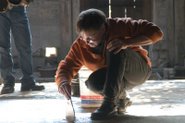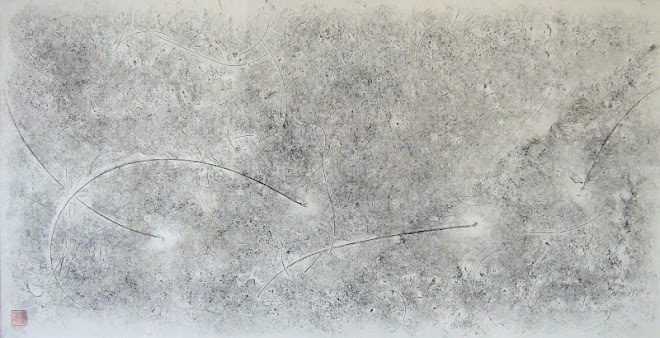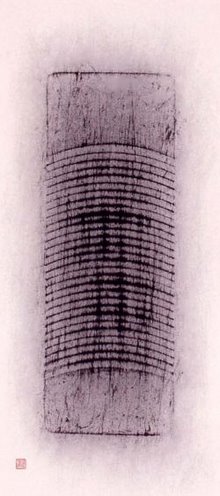ASIAN ART IN LONDON 2013
The Burrell Collection, Glasgow
.
6 November 2013
.
12:30-1pm Gallery Talk:
Form and Function: A Square Huanghuali Table
by Dr. Yupin Chung and Thomas Jacobi
As part of the Ming Furniture series, this talk will explore the exceptional craftmanship in the golden age of classic Chinese furniture.
7000 Imprints 印記 7000 Abdrucke
Yupin Chung, Midsummer 2012
What role ink rubbing plays in forming peoples' life in art?
▪ The Spiritual Relationship between “7000 Imprints’’ and “7000 Oak Trees’’
▪ Tracing the Past: The Ink Rubbing in Chinese Art
Seminar | Sonntag 9.September 2012, 15 – 16.30 Uhr
Die Sprache der Textur
"MOTES OF LIVING LIGHT"
 Short film by
Short film by ASIAN ART IN LONDON 2010

The Burrell Collection, Glasgow
.
10 November 2010
.
10-12am Chinese Ink Rubbing Workshop by Thomas Jacobi
.
12:30 - 1pm Gallery Talk: New Perspectives on Bronze Wine Vessels by Dr Yupin Chung, Curator of Chinese Art, and Thomas Jacobi, Artist. As part of Four Seasons’ Drinks in China series, the talk explores the motif, ornamentation and rubbings of inscriptions on bronze vessels from the Burrell Collection.
'CLEANSING THE HOUSE WITH INK' 以墨洗宅 DVD

'CLEANSING THE HOUSE WITH INK' 以墨洗宅

Sunday 25 April 2010, 7-9pm
poem by David Greygoose with parallel Chinese translation by Dr Yupin Chung, Curator of Chinese Art, The Burrell Collection,
music by Lin Fa and voice by award winning poet Eleanor Rees.
Poetry readings and live improvisation by Harmony Chinese Music Ensemble's award winning composer Eddie McGuire,
singer Liu Fong and musician Eng Hooi Ling.
The performances include:
'the shadow of the hand writes before the thought'
'Brushstrokes of Breath'
'Andrastes Hair '
'Eliza and the Bear'
'the shadow of the hand writes before the thought' 手影順思行 / 'CLEANSING THE HOUSE WITH INK' 以墨洗宅


"FROM A DISTANCE - AT CLOSE RANGE II"

Ricefield Arts and Cultural Centre, Glasgow, Scotland, UK
14 February - 8 March 2009 and
"KISSES FOR SHANGHAI"

View Two Gallery, Liverpool, UK.
.
As part of my exhibition "From a Distance – At Close Range" visitors were invited to 'print' their kisses onto a length of paper attached to the wall of the first floor gallery.
"Kisses for Shanghai" is the Liverpool peoples' contribution to their twin city in China. The paper will be mounted on scroll later and in 2010, during the Shanghai World Expo, the second part of the performance will take place by inviting people of Shanghai to kiss a paper for Liverpool.
.
[Photos]
"FROM A DISTANCE - AT CLOSE RANGE"

In China, the scholars appreciation and collecting of ink rubbings of stone-carved calligraphies have a long history. In the West, the attempts of alchemists to discover the secret of making gold led to another understanding of science. Thomas seeks to find the appropriate way as a contemporary artist to transcribe or to transform material through the working process in the search for the essential.
"The ink rubbings document the use of objects by humans and the traces left in material. They tell the stories, record the signs and carvings of daily life, giving evidence of past and present. The pigments are made of stone, bricks or clay, any material used to construct housing. Houses give shelter to people and also record history; working with the pigments of historic buildings sets the pure substance of colour free… The material matters – in the service of concept." Thomas Jacobi
"WATCHING THE SEA AND WAITING FOR A PAINTING TO COME"

"在那遥远的一天 巴德诶姆斯泉水 将流进厦门港湾 汤玛士到此一游"

"GERMAN GARDEN" - 德园 拓印 挂轴装裱 2005年12月

"GERMAN GARDEN" Exhibition Statement TONGJI University Shanghai
2005年秋天,透过中德艺术家交流计划,我初次到了福州。我的福州朋友带我到他们讲述的“德园”,我被那带有欧洲风格的建筑景观所震惊。据说那里是十九世纪外国人居住以及工作的地方;包括商业特许区、行政办公楼、大使馆、学校、教堂、医院、以及花园等社会的结构,显示出城市重要发展。如今,我们只见少数的旧房舍以及残存的过往痕迹。中国城市的变迁带来一种建筑知识与传统的失落,像是一个曾经有著历史经验与记忆的地区,擦去后不留痕迹。关于我们所处社会的历史定位问题,将被特意选择的地图、照片、书籍以及博物馆展览所回应。一幅提名为“德园”的挂轴,我试图以纪录的方法来转化“人类学的现场”到我的作品中。拓印石头上的书法一直是中国的传统,今日引发出一种意识,就是为历史而历史以及它所依托的物质文化。历史是活化记忆的过程,对我而言,她塑造与追溯人类的想法、情绪、以及行为,显然是个自我在世界定位的贡献。(钟瑜平博士译)
Als mich während meines ersten Studienaufenthaltes in Fuzhou im Herbst 2005 chinesische Freunde auf das Haus "Deutscher Garten" aufmerksam machten, war ich von der europäischen Anmutung der Architektur überrascht. Im 19. Jahrhundert gab es einen Stadtviertel, in dem die Ausländer lebten und arbeiteten und Straßenzüge mit Geschäftshäusern, Verwaltungsgebäuden, Botschaften, Schulen, Kirchen, Krankenhäusern und Stadtvillen das soziale Gefüge ihrer Bewohner und die Bedeutung für die Stadt bezeugten. Bei einem Besuch vor Ort konnten wir jedoch nur noch einzelne erhaltene Häuser und Reste der Bebauung finden. Die Umwandlung großer Areale der chinesischen Städte in Hochhauskomplexe verursacht einen unschätzbaren Verlust der Kenntnisse in der Baukultur und der Traditionen. Orte, die etwas bezeugen; erfahrbare Geschichte also, werden ausradiert als habe es sie nie gegeben. Die Frage nach der geschichtlichen Identität unserer Gesellschaft wird bald nur noch an Hand ausgewählter Quellen mit Karten, Photos, Büchern und Museumsausstellungen zu beantworten sein. Mein Rollbild "Deutscher Garten" ist der Versuch, mit einer dokumentarischen Arbeitsmethode "Archäologie der Gegenwart" künstlerisch umzusetzen. Die Tuscheabreibung von Kalligraphien in Stein hat in China eine lange Tradition. Heute gilt es, das Bewußtsein für Geschichte selbst in seiner Materialität zum Thema zu machen. Geschichte ist ein lebendiger Prozess des Erinnerns, der durch die Sichtbarmachung von Spuren menschlichen Denkens, Empfindens und Handelns zu unserer Selbstpositionierung in der Welt beiträgt.
During my first stay as artist in residence in Fuzhou, autumn 2005, my Chinese friends drew my attention to a house called "German Garden". I was surprised by the European style of the architecture and was told about a district from the 19th Century in which foreigners lived and worked. The infrastructure of business premises, administration buildings, embassies, schools, churches, hospitals and suburban gardens testified to the social structure of their inhabitants and the importance to the city. Visiting the quarter, we only found a few houses and fragments of the former development still existing. The transformation of large areas of Chinese cities into tower blocks causes an immense loss of knowledge of architecture and traditions. Sites, which provide experience of perceptible history, are wiped out as if they never existed. Questions about the historical identity of our society will be soon answered only by selected sources intended for this purpose, such as maps, photos, books and museum exhibitions. My scroll entitled "German Garden" is an attempt to use the method of documenting to transform "archaeology of the presence" into a work of art. The practice of ink-rubbing taken from stone calligraphy has an old tradition in China. These days raising awareness matters -- for the sake of history itself and its material culture. History is a living process of remembrance, which shapes the traces of human thinking, emotion and acting that are perceptible as a contribution to our self-positioning in the world.
"WELCOME TO CHINA!" - "歡迎來到中國!" EXHIBITION
+P2+Wu+Yi+Shan+Light+Red+%231.jpg)







+IR43+Lacquer+%233+(Third+Version)a.jpg)
+IR17+Foochow+Whispers+%231a.jpg)



.jpg)
